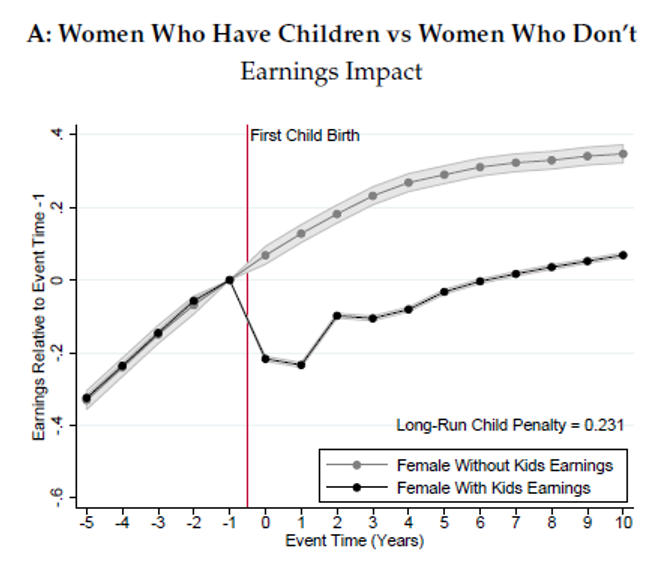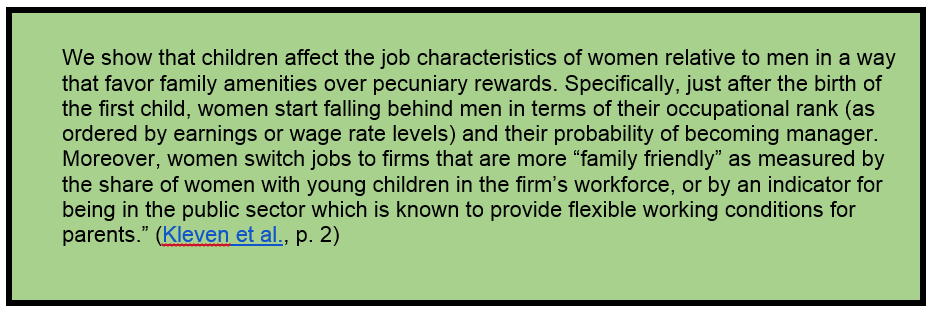How the ‘child penalty’ matters for domestic and family violence (and what we can do about it)
The ‘gender pay gap’ is a major contributor to conditions that enable and perpetuate domestic and family violence. That women on average earn much less than men increases their vulnerability to financial abuse, makes it difficult for them to leave violent relationships, and leaves them much worse off financially if they do leave. Recent research suggests that it’s the ‘child penalty’ more than anything else that is currently driving the pay gap. ANZSOG Research Fellow Sophie Yates (@MsSophieRae), who is completing a PhD at UNSW on gender and domestic and family violence, reflects on the importance of changing our expectations about who will take care of children if we want to significantly reduce family violence.
The US National Bureau of Economic Research recently published research that reached a startling conclusion: today’s ‘gender pay gap’ is almost all due to having kids - what the researchers have termed the ‘child penalty’. Henrik Kleven and colleagues looked at administrative data for the population of Denmark for the period 1980-2013. It’s important to note that these findings include all men and women in the dataset, so this research doesn’t just compare full-time workers to other full-time workers. This enables them to take into account things like women’s leaving the workforce or working less, or moving to more flexible or ‘family friendly’ workplaces, as well as their likelihood of being promoted. The Denmark data is likely to be relevant to other countries, since even though Denmark has some of the most progressive gender policies in the world, the pay gap there is similar to that of other developed countries such as Sweden, the UK and the US (all between 15-20% for full-time workers). In Australia, the pay gap in full-time earnings has hovered between 15-19% for the past 20 years.
Equalising parenting, caring duties and housework will reduce the gender pay gap and keep women and children safer. Photo credit Pexels.
These two graphs lay out some of the main findings: firstly, that (compared to women who don’t have children) women’s earnings after their first child significantly reduce and don’t re-converge with childless women, and secondly that having children has almost no impact on men’s earnings.
Source: Kleven et al., p. 42
Research from my ANZSOG colleagues Argyrous et al. supports this in the Australian context - they found that the birth of a couple's first child significantly impacted the paid working hours of the mother, but had almost no impact on the father. Another interesting point is that the earnings trajectory of women without children is very similar to that of men, a fact illustrated in a different way by the following graph:
Source: Kleven et al., p. 45
This graph shows that since 1980 the proportion of the ‘gender pay gap’ that is due to education-related disparity between women and men, or to other gendered inequalities, has diminished to almost nothing. In other words, the difference in income between men and women is now almost entirely due to children.
The components of the ‘child penalty’
It’s not just that women with children work fewer hours, argue the authors:
So mothers work less than fathers (and women without children), are more likely to choose their workplace based on how family-friendly it is rather than what it does for their earning power, and are less likely to become managers. Men, on the other hand, follow the same earnings trajectory whether or not they have children. This applies to Australia too, where (as an indication of men’s childcaring responsibilities) only 5% of people who took primary carer parental leave in 2016 were men. ANU research confirms that Australian men average 16.4 more monthly hours at work than women – time that is directly correlated to advancement and promotion. As criminologist Michael Salter notes, these economic factors result in “entrenched gender disparities in lifetime earnings, wealth, and superannuation/pension accumulation” (p. 4).
Women also complete much more unpaid caring and domestic work than men; worldwide, women do approximately 2.5 times as much of this work as men, and in Australia 1.8 times as much as men (UN Women 2015, p. 84 and 269). Even women who work full-time do more unpaid caring and domestic work than men. Not only do these factors result in women being economically worse off than men, they also impact women’s social and support networks. Time spent on unpaid labour is time unspent on the development of skills and networks outside the home.
What does this have to do with domestic and family violence?
What this boils down to is that women who depend on men for most or all of their income, and spend the majority of their time keeping the house running and taking care of children, can find that if their relationship becomes abusive, they have few economic or social resources to turn to. In fact, women earning less than male partners - coupled with traditional views about a man’s place as the head of the household - can result in a power disparity that makes abuse more likely to happen in the first place. It’s difficult for women in this position to leave relationships, and if they do leave they may end up very financially distressed, unable to take care of their children, and even homeless. These considerations - especially the thought of not being able feed, clothe and house their children - keeps many women living in or returning to unhappy, violent situations. Unhappily, changes to welfare also limit women’s choices when it comes to leaving relationships.
Not to say that domestic and family violence only happens to women who earn much less than their partners. It can happen to people of all genders, socioeconomic brackets and working arrangements. But women experiencing the ‘child penalty’ certainly have more difficulty avoiding and extricating themselves from violent relationships than those whose economic and social resources match their partners’.
Decoupling motherhood from primary caregiving
What can we do about the child penalty and its implications for domestic and family violence? Probably the biggest and most ambitious social change we need is the decoupling of motherhood from primary caregiving. Gender - and by that I mean the expectations, norms and structures associated with being a woman or being a man - positions women as primary caregivers to children, with the lion’s share of responsibility for their safety, nurturing and welfare. Because of this almost inevitable assumption that when women become mothers they will spend more time caring for them than fathers, gender sets families up to give men increased financial and social power over women. If we change this dynamic and create an expectation that men and women will be equally involved in raising children, caring for elderly parents, and running households, much of the remaining ‘gender pay gap’ - and thus a significant part of the power disparity in families that enables domestic and family violence - will be reduced.
But there is no one solution to making this radical social change. Many years ago, sociologist Barbara Risman investigated what ‘success’ looked like in the creation of egalitarian relationships between couples, and what conditions enabled this success. She summarised this work in her seminal article “Gender as a social structure: Theory wrestling with activism”. Through an ethnographic study of heterosexual couples who shared paid work, childcare and housework within a 60/40 split (in either direction), she realised that the conditions for success were numerous and operated at multiple levels of the ‘gender structure’.
Individually, the women in these egalitarian relationships had strong personalities and a sense of direction; the men tended to be laid back and not concerned with appearing typically ‘masculine’. On a cultural and interactional level, the couples were committed to equality and actively strove to create social relationships with likeminded people. Structurally, the women’s income and career status matched or bettered the men’s, and - crucially - the men were employed in flexible jobs (as well as some, but not all, of the women). These couples experienced enabling contexts at all levels of the gender structure, and understanding their ability to create equal relationships required paying attention to each level.
This rings true for me, as it exactly mirrors my childhood experiences. My mother is strong and driven, and my father comparatively laid back. They were committed to gender equality and so were their friends. They chose to work in a profession that allowed flexibility (my father reminisced recently about ‘handballing’ infant me from one parent to the other as they juggled paid work and childcare responsibilities), and my brother and I spent a fair amount of time in aftercare at school. I can’t remember ever feeling that one of them had more responsibility for our care than the other. And they certainly raised a feminist. As Risman summarised:
By increasing women’s sense of agency and self-efficacy, by reducing pressure on men to be primary breadwinners, by providing role models of mothers and fathers who share paid and unpaid work equally, by providing affordable childcare, and by creating workplaces and social structures that encourage men to reduce their paid working hours to care for children, we can stop women bearing the brunt of the ‘child penalty’. And through doing this, we can address one of the primary drivers of domestic and family violence.
This post is part of the Women's Policy Action Tank initiative to analyse government policy using a gendered lens. View our other policy analysis pieces here.







